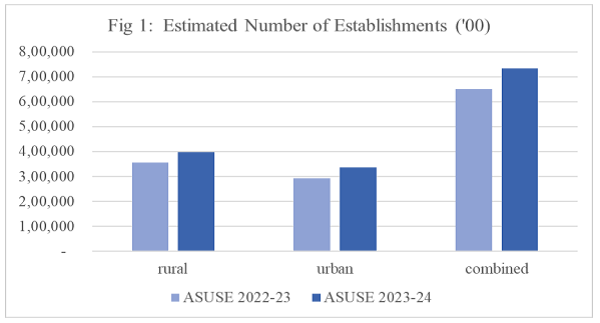




On 2 January 2025, the Ministry of Statistics and Programme Implementation (MoSPI) released the results of the Annual Survey of Unincorporated Sector Enterprises (ASUSE) 2023-24, for the reference period October 2023 to September 2024.
It is pertinent to know about what is “unincorporated sectors”, before going to the findings/results of the ASUSE 2023-24. In this article, we will also see the necessity and evolution of ASUSE and will end with a conclusion.
What are Unincorporated Sectors?
According to the OECD Glossary of Statistical Terms, “An unincorporated enterprise is a producer unit which is not incorporated as a legal entity separate from the owner (household, government or foreign resident); the fixed and other assets used in unincorporated enterprises do not belong to the enterprises but to their owners, the enterprises as such cannot engage in transactions with other economic units nor can they enter into contractual relationships with other units nor incur liabilities on their behalf; in addition, their owners are personally liable, without limit, for any debts or obligations incurred in the course of production.”
The ASUSE survey is an integrated survey capturing economic and operational characteristics of unincorporated non-agricultural enterprises in manufacturing, trade and other services sectors (excluding construction) to supplement the corporate sector data. Broadly, this survey includes the informal sector.
Therefore, the unincorporated sector is also known as the unorganised sector or informal sector.
Necessity and Evolution of ASUSE
Recognizing the importance of unincorporated non-agricultural businesses in India, a yearly survey was designed to track them. The National Statistical Survey Organisation (NSSO) came up with the idea of developing this yearly survey, which resulted in the birth of the Annual Survey of Unincorporated Sector Enterprises (ASUSE).
The survey is meant to exclusively measure various economic and operational characteristics of unincorporated non-agricultural establishments in manufacturing, trade and other services sectors (excluding construction).
The ASUSE follows an establishment approach though by name, it is known as an enterprise survey.
The unorganised sector plays a vital role in the Indian economy. This sector is essential to generate employment, nurture entrepreneurship and contribute to the country’s Gross Domestic Product (GDP).
The ASUSE’s main objective is to systematically collect information on financial, structural and operational characteristics of the unincorporated units.
The results of this survey provide essential inputs for policymakers (in both the government and private sector) for their strategic planning and decision-making.
The first comprehensive survey of ASUSE was carried out in 2021–2022, from April 2021 to March 2022. The second ASUSE 2022-23 survey took place from October 2022 to September 2023.
The factsheet of the report is put together as a Fact Sheet of the Annual Survey of Unincorporated Sector Enterprises (ASUSE) 2021-22 and 2022-23.
The present/current, which is the third survey report, the ASUSE 2023-24, was carried out from October 2023 to September 2024.
Results and Findings of the survey
This extensive survey reveals the economic and operational aspects of the unincorporated non-agricultural sector, emphasizing its significant role in employment, Gross Domestic Product (GDP), and the broader socio-economic framework of India.
Significant Sectoral Growth
There is significant growth in the unincorporated sector with the total number of establishments increasing from 6.50 crore in 2022-23 to 7.34 crore in 2023-24, with a remarkable increase of 12.84%.
The “Other Services” sector saw a growth of 23.55%, while the manufacturing sector experienced a 13% increase during the same timeframe.
Concurrently, the Gross Value Added (GVA),which is an important measure of economic performance, increased by 16.52%, largely due to 26.17% growth in the ‘Other Services’ sector.

Expansion of Employment
In 2023-24, employment in this sector witnessed considerable growth with over 12 crore workers – this is an increase of more than one (1) crore from the previous year.
The list was topped with the “Other Services” sector, with employment growth of 17.86%, followed by the manufacturing sector with an increase of 10.03%.
The average salary for hired workers increased by 13%, indicating enhanced wage levels and a robust economic demand. The manufacturing sector reported the most considerable wage growth, surpassing 16%.

Gender inclusivity progress within the sector is demonstrated by the growth of female-owned businesses – as they increased from 22.9% in 2022-23 to 26.2% in 2023-24.

Labour productivity
The labour productivity indicator known as Gross Value Added (GVA) per worker, experienced growth to Rs. 1,49,742 in 2023-24 with an increase of 5.62% from the previous year’s figure of Rs. 1,41,769 in 2022-23 in the current prices.
Concurrently, the Gross Value Output (GVO) per establishment increased from Rs. 4,63,389 to Rs. 4,91,862 in current prices.
Digital Adoption
Due to digital adoption, Internet usage increased from 21.1% in 2022-23 to 26.7% in 2023-24, which indicates a growing reliance on digital tools for business operations.

Conclusion
The ASUSE 2023-24 report highlights the remarkable growth across the unorganised (unincorporated) sectors with improved digital penetration and wage levels that underscore the unincorporated sector’s resurgence as an important contributor to India’s economic recovery.
However, there is a decline in the Percentage of Hired Worker Establishments, across the sector, from 15% (14.94% to be precise) in 2022-23 to 14% (13.65% to be precise) in 2023-24.
There is a decline in the Percentage of Hired Worker Establishments in manufacturing, from 13% (12.72% to be precise) in 2022-23 to 12% (11.75% to be precise) in 2023-24.
There is a marginal decline in trade too from 16.13% in 2022-23 to 15.95% in 2023-24.
In terms of GVA in manufacturing, there is a decline in GVA per establishment from Rs. 2.02 lakh in 2022-23 to Rs. 1.89 (approx.) lakh in 2023-24 and also a decline in GVA per worker from Rs. 1,17 lakh to Rs. 1.13 lakh (approx.) in 2023-24.
India’s unincorporated sector has been reviving establishments, employment, and productivity over the past few years, as seen in the ASUSE 2023-24 results/factsheet.
The unorganised sector is one of the main drivers of the Indian economy’s growth story. However, the unincorporated sector does not have a proper accounting measure to include it in the GDP calculation.
Nevertheless, this survey gives a glimpse of how important the sector is and why policymakers should not ignore the unorganised sector in their planning and policy measures.




